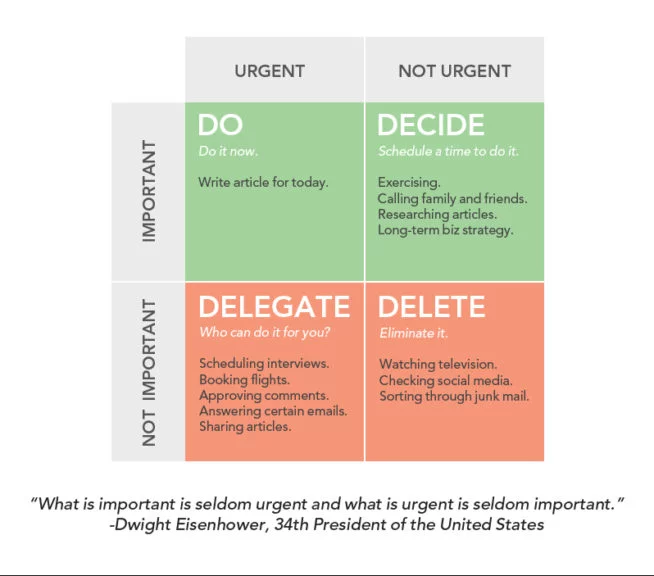It’s the end of your day. You feel overloaded, stressed, and overwhelmed by all the things you need to accomplish at work and in your personal life.
You put your head on your pillow but tasks you forgot to write down pop into your head reminding you that tomorrow will be another long day.
Don’t fear! You are not alone with all those stressful thoughts.
Researchers show that around 60% of the Japanese population is under constant stress, 13.5 million workdays in Europe are lost yearly due to stress, and 83% of US workers report being under significant stress. (Take a quick pause now, and breathe deeply! I promise this article will get better).

We have this constant, nagging feeling of trying to fix and manage our external environment rather than looking inward.
How well do you know yourself? What are your values? What are your strengths and weaknesses?
If I ask you today: Who is the most important person in your life? Who would the answer be (honestly)?
I hope you said: you.
Every day, everyone wakes up with the same amount of time to make any decision they want. However, most of those decisions are being done to please someone else. And, little by little, we start to forget about ourselves—the most important person in our life.
Because let’s face it, you cannot take care of your loved ones if you’re not taking care of yourself.
It’s time for you to take control of your life and be accountable for your actions without putting the responsibility on the other or on external factors. Free yourself from things you cannot control and start assessing what you can by knowing yourself.
An easy way to explain this and start shifting your perspective is by looking at how you see time. The term ‘time management’ does not hit the heart of the problem because it’s not about managing time.
Time cannot be changed, but you can. It’s about finding a technique that will help you perfect your way of working on yourself.
This is called self-management.
What’s Self-Management, And Why Is It Important?
Self-management is the competence to shape one’s own personal and professional development independently of external influences. You are in charge of your own destiny. This means it’s up to you to find your place in the world and know when to change course.
Peter Drucker, author of the book “Managing Oneself” emphasizes that we live in an age of unprecedented opportunities. However, these choices also require taking responsibility for one’s own development and personal maturity. He says:
“Knowledge workers must, effectively, be their own chief executive officers”.
This means that you are both a company and a manager. Your body and mind personify the company through its beliefs and physiological qualities. Your behavior and how you handle your decisions to bring this business to prosper represents your role as a manager.
But why is this important?
A large part of the working population is chronically stressed. Some are already at the end of their strength and suffer from the symptoms of overwork, such as burnout.
Self-management comes into play to help you become more self-aware. It enables you to achieve the life you want and stop blaming external factors for your problem. When learning how to manage yourself, you recognize the impact of your emotions and thoughts on a given action. It makes you responsible and equipped to evaluate your work and determine the way to proceed.
4 Self-Management Techniques To Put You In The Center Of Your Life
Now that you’ve learned what self-management is, let’s look into how you can start managing your life. Here are three important things to keep in mind:
- Start with a goal. Don’t live a busy life. If you don’t know where you want to be, it’s unlikely you will be able to manage yourself meaningfully. Define your objectives and set goals at all levels.
- It’s not a 9-to-5 job, it’s a daily choice. It’s a way of thinking and can not be switched off after work. Sometimes, you may think it’s a weekly choice, it’s fine! It takes time to build it.
- Make a plan. Plan a strategy to achieve the goal and implement it.
There are many ways you can put into action the life you want to live. The best way to start is by testing a few techniques while being conscious of the decisions you’ve made throughout the process.
1. Adopt The ‘Getting Things Done’ Framework To Stay Organized
According to David Allen, creator of the “Getting Things Done” methodology:
“Self-management is about knowing what to do at any given moment”.
The GTD framework helps you achieve that. The idea is simple — clear your mind for important things by capturing and organizing all the tasks that need to be done in a logical system. This allows you to take control of what needs to be done, avoiding any mental distractions so you can focus on execution.
The GTD framework is based on five steps:
- Capture all the things! Your ideas, recurring tasks, long emails responses, meetings, everything.
- Clarify the things you have to do. This is the time to decide if that task needs action or not.
- Organize those action tasks by priority and category. Assign due dates when possible.
- Reflect on your to-do list. This is when you revise all the system and pick what your task should be.
- Engage and get to work. At this stage, all your tasks are organized by priorities and broken down into actions. You know exactly what you should be doing.
Conscious Tip: When reflecting on what tasks needs to be accomplished, think about the emotional outcome of that action. How are you going to feel while doing it and completing it? Try to categorize your list in a balanced way where you have a task that will make you feel “you are a good person in the world”, for instance, and another task where you feel tedious about it but you know it needs to be done (e.g. doing your taxes).
This way you stop trying to find valuable things to do and start finding the value in the things you are already doing.
2. Practice The Pomodoro Technique To Boost Your Focus
Avoid task hopping by using the Pomodoro technique. The idea is to choose one task and make the small commitment of spending 25 minutes completely focused on it, followed by short breaks of 5 minutes. After four cycles, allow yourself a break of 30 minutes.
This technique will only work if you set your environment to avoid interruptions, whether external like constant pings on Slack, or internal like your own thoughts and emotions. I would like to focus on the latter since it’s much easier to shut down an app and not so easy to ease the mind.
Before you go into your deep work mode, take a few breaths and assess if that task triggers any discomfort on you.
For instance, while working on a presentation for your directors, you have a persistent voice in the back of your mind saying “I am not good at this”. According to a study, if this is left unaddressed, this thought can cause a bad mood, procrastination, and/or self-doubt — a feeling associated with characteristics of imposter syndrome.
Take a moment to acknowledge your emotions or thoughts by writing it down. From there, you can either decide to find closure, or put it to rest for now, and bring your attention back to your focus (the NOW task).
Conscious Tip: Keep a journal (analog or digital!) to write down any thoughts or emotions that came through while focusing on a task. This will help you increase your self-awareness and understand what initiatives trigger discomfort and what motivates you.
3. Use The Eisenhower Matrix To Prioritize And Delegate
One way of improving self-management is by prioritizing your urgent and important tasks. The Eisenhower Matrix can help you achieve that and also understand what can be delegated. It’s split into four boxes:
- Important/Urgent
- Important/Not Urgent
- Not Important/Urgent
- Not important/Not-Urgent.
Below is an example of how it can be used:

The key when using this technique is to reflect and identify which quadrant you spend the majority of your time. If you spent too much time on tasks that are Urgent and Important, you will end up being burnt out, stressed, and continually putting out fires instead of being proactive.
On the other hand, if you spend most of your time on Not Urgent and Not Important tasks, that means that you are not in the center/in control of your life, being irresponsible and dependent on other people or institutions for your basic needs.
Conscious Tip: At the end of the week, sit down for the last hour to evaluate how this system worked for you. Ideally, you want to be working on tasks that are on the Not Urgent/ Important quadrant which means you are focusing on your vision, mission, and things that you can control.
4. Learn To Say No To Stay True To Your Goals
When you say yes to another project or to help a coworker on something “quickly,” it means you are effectively saying no to the tasks you have already prioritized. Take your time before committing to doing another task. Sometimes, saying “Can I get back to you on this?” gives you the opportunity to delegate, research more about the new task, or ask the experts for more information.
Conscious Tip: Improve your self-esteem and your confidence by evaluating your own worth and learning to say ‘no’ in certain circumstances.
Self-Management Is A Work In Progress
A successful self-management strategy is a multi-year process and it is in constant evolution. It takes time for you to find which prioritization and productivity styles work for you and what which ones need more time to prosper.
Start small by trying out one of the techniques today for a month. These tips should help you do more, acknowledge what you get done, be grateful, correct your course as needed, and be a better person at home and at work.
Next: The Top 5 Blockers To Your Productivity (And How To Hack Each One







































